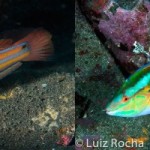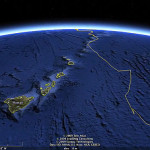
Figure 2 from Etnoyer and Warrenchuk (2007). Callogorgia americana delta colonies with catshark egg cases attached. Depth 533 m.
ROV suction hose on the left is 15.25 cm (6 in) in diameter.
One potential piece of evidence that would provide a very clear indication of the relationship deep-sea fish and coral would be the discovery of an egg case attached to a coral. Simple, neat, and elegant proof that corals provide nursery habitat. As Peter mentions in the article, observations like this are rare (~5) and usually represent an observation of single egg case.
 Peter and Jon Warrenchuk describe results from a 2003 expedition to 3 sites in the Gulf of Mexico between 340 and 538m. During this work over 296 egg cases attached to 117 gorgonian corals were discovered! The eggcases are consistent with those laid by Scyliorhinus retifer, the chain catshark (picture right, image from Marinebio.org). The chain catshark is charismatic species with elegant patterned that feeds on small crustaceans, cephalopods (that’s not right), fish. Peter and Jon suggest that the rough texture on Callogorgia corals may enhance egg case adhesion. A benefit of placing an eggcase on coral, besides shelter, would be to increase water circulation around the eggcase. Water near the sediment interface moves slowly and is typically has less oxygen because of respiration by organisms living in and on the mud. This region near the sediment is called the benthic boundary layer (BBL). By placing eggcases on corals that rise out of the BBL more oxygen can reach the developing young.
Peter and Jon Warrenchuk describe results from a 2003 expedition to 3 sites in the Gulf of Mexico between 340 and 538m. During this work over 296 egg cases attached to 117 gorgonian corals were discovered! The eggcases are consistent with those laid by Scyliorhinus retifer, the chain catshark (picture right, image from Marinebio.org). The chain catshark is charismatic species with elegant patterned that feeds on small crustaceans, cephalopods (that’s not right), fish. Peter and Jon suggest that the rough texture on Callogorgia corals may enhance egg case adhesion. A benefit of placing an eggcase on coral, besides shelter, would be to increase water circulation around the eggcase. Water near the sediment interface moves slowly and is typically has less oxygen because of respiration by organisms living in and on the mud. This region near the sediment is called the benthic boundary layer (BBL). By placing eggcases on corals that rise out of the BBL more oxygen can reach the developing young.
Etnoyer, P. & Warrenchuk, J. (2007) A catshark nursery in a deep gorgonian filed in the Mississippi Canyon, Gulf of Mexico. Bulletin of Marine Science. 81:553-559.






Cool! The only time I’ve seen a chain catshark was years ago at the Mystic Aquarium in CT, but it was certainly a stunning animal. I always loved that Richard Ellis illustration of it, too.